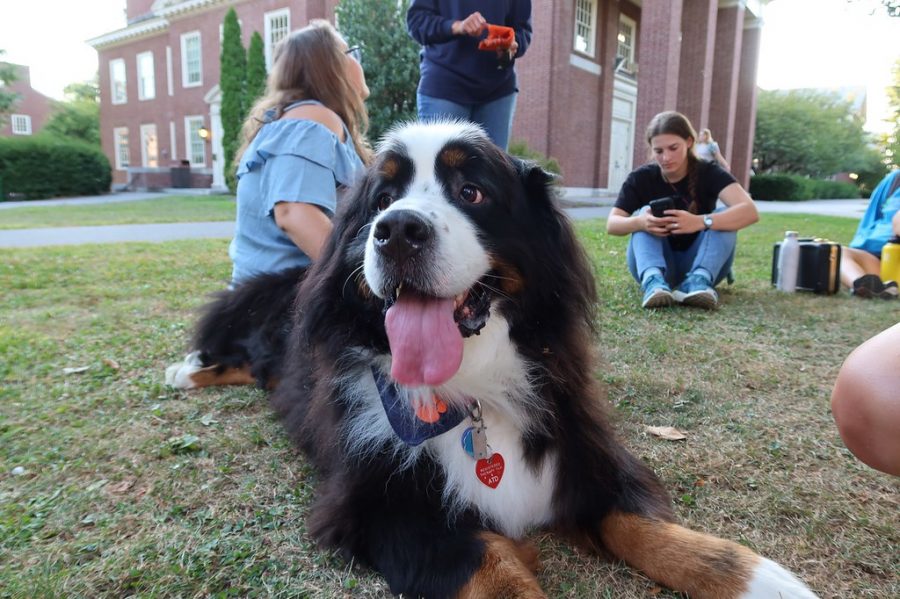Pups for positivity
November 14, 2019
Therapy Dog Sessions
Every student could use a much-needed break from studying, especially when it involves petting therapy dogs outside of Bertrand Library. While these furry friends visit the University all throughout the semester, they have a tendency to appear at the mid-semester slump or around finals week.
Psychological Benefits
Psychological studies have proven the benefits of therapy dog sessions to stressed students; these advantages include an immediate increase in happiness and energy levels with a simultaneous reduction in stress levels, as reported on the American Kennel Club’s (AKC) website. Additionally, the AKC boasts that therapy dog sessions help students cope with negative emotions and perceive more positive social support in the long-term.
The Susquehanna Trail Dog Training Club (STDTC)
The therapy dogs students may spot in front of Bertrand Library belong to members of the Susquehanna Trail Dog Training Club (STDTC). STDTC has had a long relationship with the University and its students, bringing its therapy dogs to campus for at least 15 years. Habitually, these dogs will stop by the University four times a semester, including during finals, of course, and at the beginning of the year.
Founded in 2004 by dog trainer Dixon Cuff, the STDTC organization is run today with the help of Connie Cuff, Dixon’s wife. In addition to visiting the University’s students, the therapy dogs make trips to nursing homes, schools, prisons and hospitals. Local residents and community members interested in training one of these lovely pups can reach out to the organization about becoming a certified Canine Good Citizen.
Coming to Campus
The relationship with the STDTC began as an initiative of the University’s Counseling & Student Development Center to promote mindfulness and cognizant practices. This program is called the “Mindfulness Menu,” and it features other events, such as 7th Street MakerSpace collaborations, mental health yoga sessions and mindful coloring hours. This “Mindfulness Menu” aligns with the theory of Koru, a type of philosophy that utilizes traditional practices–like breathing exercises, visualization and guided meditation–to reduce stress and anxiety.
For the Dogs
Moreover, while the University and its Counseling & Student Development Center originally focused on forming this relationship with STDTC and their therapy dogs to provide students with coping methods for anxiety and stress, one might say that the program benefits the dogs as much as the students.
In memory of Dixon Cuff, the founder of STDTC, the program emphasizes the health and well-being of its dogs. The organization and its members ensure that its enrolled dogs are cared for properly and are healthy.
“In his last training class Cuff had enrollees sign in and place checkmarks on a page with four columns headed, ‘Weight,’ ‘Cleaned Teeth,’ ‘Brushed Dog,’ ‘Practiced Lesson,’” Sherry Carpenter, a member and blogger of STDTC, said. In addition to being involved in training dog programs in the Susquehanna Valley, Carpenter has contributed her writings to the American Kennel Club Gazette and the Sunbury Daily Item, some of which have been awarded with the Pennsylvania Veterinary Medical Association. “Obesity was the number one problem in pets in 2005 and still is. [Cuff] was the first trainer to recognize that and encourage other dog owners to recognize it,” Carpenter said.
Payoff to Students
Psychology major Abby Tate ’22 sees the scientifically-proven benefits of the therapy dog program, such as reducing stress and increasing reflection. “I think therapy dogs are beneficial to students and faculty because they bring to campus an aspect that a lot of people miss from home,” Tate said. “Lots of people have pets and miss them dearly, especially when they are stressed. The dogs allow me to pause for a few minutes and regain perspective with my stress.”
About the general stress induced from educational climates, Tate said, “We’re constantly pushing ourselves academically at school, and the dogs are a fun way to just come back to reality and take a breath of air during the constant chaos.”
Tori Bartlett ’21 has also attended the therapy dog sessions at Bertrand Library and agrees about the program’s benefits. “I think it’s actually a nice break, especially during finals when I’m studying more intensely,” Bartlett said. “The program obviously helps students destress, but it’s also good for these therapy dogs to get acquainted with large groups of people since they are training to tend to others in hospitals or nursing home communities.”
“It’s always a nice surprise seeing the therapy dogs on the quad or in the library,” Ally Hurdman ’21 said about her enjoyment of the program. “Often I don’t know they are coming or I forget which day it is so when I walk up to the quad to follow the same routine of going to do work, seeing the dogs there puts a smile on my face. The therapy dogs never fail to brighten my day and I see that in the people around me, too.”























rannaran • Nov 17, 2019 at 6:54 am
Hey do you have any information about this dog training program https://bit.ly/2CPCpvZ ??
It looks like a great program to help people dog training. I was just looking for some opinions, by the way I love your content keep doing this good work.